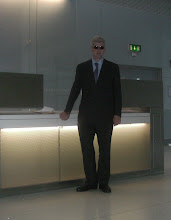HUMAN ARM ANATOMY

How it works; in the upper arm, two groups of muscles have to function in opposing pairs (flex or groups and extender groups) to move the elbow joint. The biceps brachii muscles cause flexion in human arms. The extender groups are triceps brachii muscles which lie on the posterior of the upper arm. The position of the biceps brachii muscles is anterior to the bone and inserts in front of the fulcrum point, which allows it to create elbow flexing. The position of triceps brachii muscles is posterior to the bone and inserts behind the fulcrum point, which allows it to create elbow extension. Muscles that move forearm at the elbow joint In finger flexion movement, there are two major muscles which are the flexor digitorum profundus and flexor digitorum superficialis. The extensor digitorum communis used to extend the finger with artificial muscles that move the four fingers.
ARTIFICIAL MUSCLES;
The artificial muscles was used in this work due to its soft movement and high power to weight ratio. Its weight is only 0.2 kg not including the connectors at both ends. The artificial muscles or rubber tuators consist of the inner rubber tube where the natural rubber latex through the vulcanizing process have been used. The rubber tube was made by dipping the mould into the rubber latex and dry at room temperature which is around 32 degree of celsius in Thailand. The outer shell is the braided sleeve. The assembly of the rubbertuator is shown where one side is the air inlet and the other side is a closed end. In this experiment, the diameter size of 20 mm with the length of 120 mm have been tested in the arm. and here is a full video presentation of what is to come with attached uncovered arm where a battery can be used.
with these designs it is hoped that the prosthetic can be used even with the complex requirement of sport, that can be replaced easily at the fixed joint. This is only one of many designs. When the artificial muscle was inflate by compressed air, it contracts and causes the radial expansion and tensile forces at both ends. The maximum tensile force of this artificial muscle is about 110 N. The arm design at the elbow joint was based on the two muscles installed in opposing pairs similar to biceps and triceps in human. The flexing of the four fingers were pulled by the four artificial muscles similar to the flexor digitorum profundus and flexor (FL.) digitorum superficialis. In the extension stroke, the four fingers are pulled by the four pieces of steel measuring tape acting like springs. At each of the fingers, the artificial muscle is basically pulled against the force of a spring which is inserted inside the finger.
HOW IT'S MADE; Metal rubber is a new process that works instead of just mixing different materials together, like in a blender or weaving metal wire components into fabrics, NanoSonic's manufacturing technique is a bit like 'growing' textiles in a makeshift washing machine. It's called "electrostatic self-assembly." By dipping the base material into baths of alternating electrons and protons, those nanoparticles with opposite charges attract and stick to each other like Velcro. So many different properties can be linked together without the material falling apart when it is washed or stretched. Each dip adds one layer. The e-textiles are lower in weight, with lower manufacturing costs and few byproducts, plus they can withstand repeated washings without falling apart.With the prosthetic forming a drum to manipulate joints to work it still in the early stages of plans. with the hope to bring a light weight strong vest type prosthetic, with this first blue print from Wise Labs.



No comments:
Post a Comment